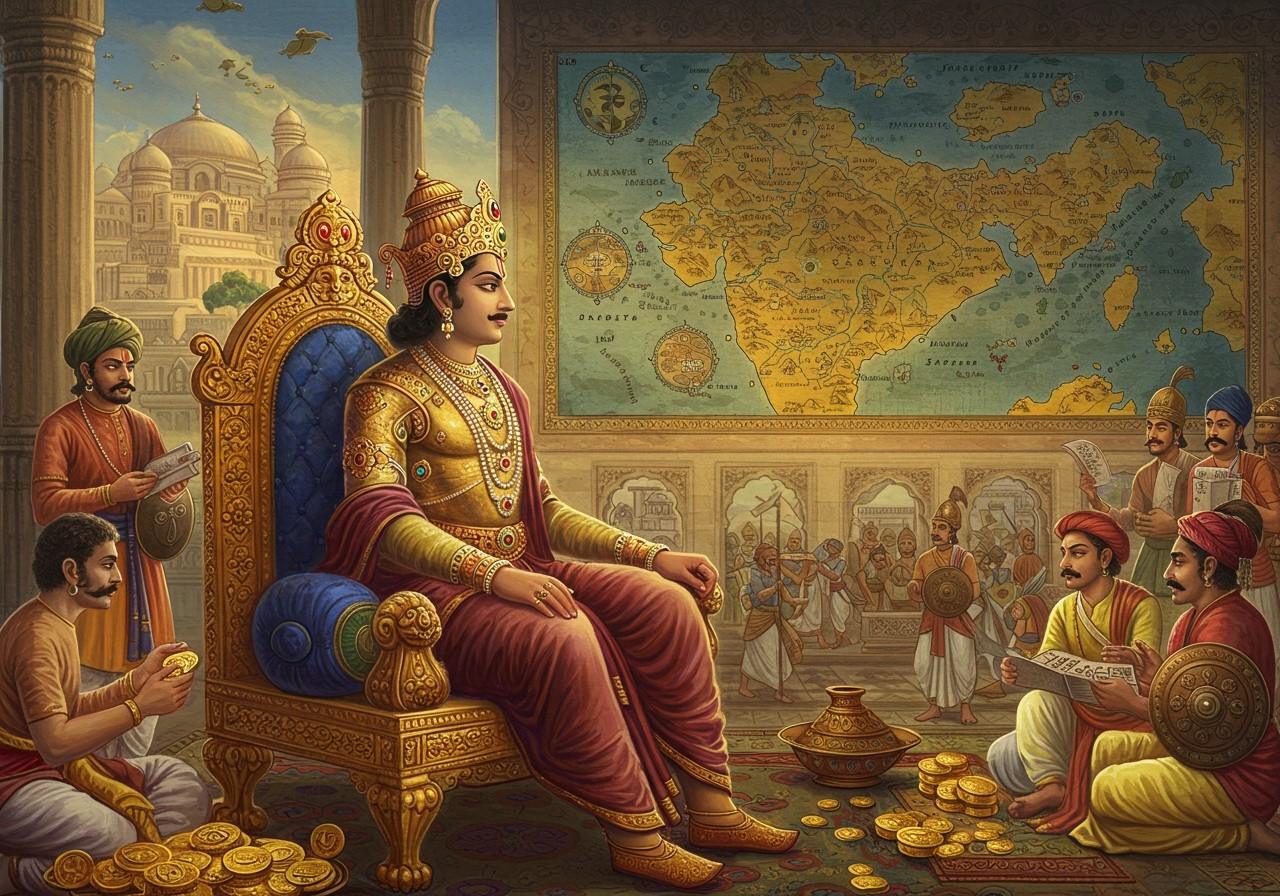
The Gupta Era, often hailed as India’s Golden Age (approximately 319-550 CE), stands as a testament to magnificent achievements in arts, sciences, and governance. This era owes its genesis to Chandragupta I, a monarch whose reign (approximately 319-335 CE) laid the foundation for a flourishing empire. This blog post delves into the life and accomplishments of Chandragupta I, exploring his pivotal role in shaping this transformative period in Indian history.
The Rise of Chandragupta I and the Genesis of the Gupta Empire
Chandragupta I ascended to power around 319 CE, marking the commencement of the Gupta Era. His marriage to Princess Kumaradevi of the Licchavi clan proved a masterstroke, significantly bolstering his political standing and territorial influence. This alliance brought legitimacy and resources, solidifying his authority and paving the way for the expansion of the Gupta Empire across northern and central India. He is known to have held the title Mahārājadhirāja (“Great king of kings”), signifying his imperial authority.
- The Gupta calendar, commencing in 320 CE with Chandragupta I’s ascension, became the standard chronological system throughout the empire, reflecting his influence and the significance of his reign. It marked the beginning of a new era of prosperity and cultural efflorescence.
- Chandragupta I’s patronage of Hinduism played a vital role in establishing it as a prominent religion, fostering the development of religious institutions and practices. His support for Hindu scholars and temples helped strengthen the religious fabric of the empire.
Chandragupta I’s Strategic Legacy: Building an Empire
Chandragupta I was not merely a ruler; he was a strategist and builder. His shrewd political alliances, combined with strategic military campaigns, expanded the Gupta territories significantly. He laid the groundwork for a robust administrative system and governance structure, which his successors would further develop.
These policies proved instrumental in shaping the empire’s trajectory and ensured its continued growth and prosperity under later Gupta rulers. His reign established a strong military, political, and economic base, which laid the foundation for what is known as India’s Golden Age.
The Lineage of Power: From Chandragupta I to Samudragupta
Samudragupta, Chandragupta I’s son and successor, inherited a thriving empire. His upbringing and education, influenced by his father’s reign, prepared him for the challenges of leadership. While the transition of power was not without its complexities, Samudragupta navigated them effectively, further expanding the empire and consolidating its power.
- Samudragupta’s military prowess led to significant territorial expansion, establishing the Gupta Empire as a dominant force in the region. His campaigns are documented in inscriptions, revealing his strategic brilliance and military achievements.
- Following in his father’s footsteps, Samudragupta continued the patronage of arts and culture. The Allahabad Pillar inscription, a testament to his reign, stands as an example of the flourishing literary and artistic traditions of the time. It provides valuable insights into his life and accomplishments.
Continuing the Legacy: Chandragupta II and the Golden Age
Chandragupta II, also known as Vikramaditya, Samudragupta’s son, further solidified the Gupta Empire’s position as a beacon of cultural and intellectual achievement. His reign is considered the high point of the Gupta Era.
- Chandragupta II’s court became a center of artistic and intellectual activity. Literary giants like Kalidasa and scientific luminaries like Aryabhata flourished during his reign, producing works that continue to be revered today. This period saw significant advancements in literature, astronomy, mathematics, and medicine.
- The establishment of extensive trade routes under Chandragupta II’s rule fueled economic prosperity, connecting the empire to distant lands and facilitating the exchange of goods and ideas. This fostered economic growth and cultural exchange.
Connecting to the Gupta Legacy with Poojn.in
At Poojn.in, India’s leading online store for cultural and religious goods, you can find a wide array of products that connect you to the rich traditions of the Gupta Era. Explore our selection of authentic items, carefully curated to enhance your spiritual practices and help you honor the legacy of this remarkable period.
- Ashoka Chal Powder: Used in traditional Ayurvedic practices, Ashoka Chal is known for its medicinal properties and continues to be revered for its significance in ancient Indian traditions.
- Mangalam Camphor: An essential element in Hindu rituals, camphor is used to purify the atmosphere and enhance spiritual practices, connecting you to the ancient rituals of the Gupta period.
- Pooja Asan (Prayer Mat): Create a sacred space for your prayers and meditation with our beautifully crafted Pooja Asans, enhancing your connection to the divine.
Visit Poojn.in today to discover our complete collection and enrich your spiritual journey.
Conclusion
Chandragupta I’s reign (approximately 319-335 CE) stands as a pivotal moment in Indian history, marking the beginning of the illustrious Gupta Era. His strategic vision, political acumen, and military achievements laid the foundation for a golden age of prosperity, cultural flourishing, and intellectual advancements. His legacy continued through his successors, Samudragupta and Chandragupta II, who further expanded and enriched the empire. Studying the Gupta Era, beginning with Chandragupta I, provides a deeper understanding of India’s rich historical tapestry and its enduring contributions to world civilization.
Explore more about Hinduism and its rich traditions:


